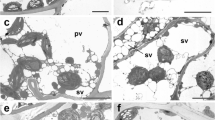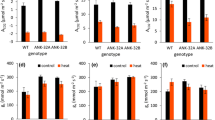Abstract
The effect of high temperature (HT) and dehydration on the activity of photosynthetic apparatus and its ability to restore membrane properties, oxygen evolution, and energy distribution upon rehydration were investigated in a resurrection plant, Haberlea rhodopensis. Plants growing under low irradiance in their natural habitat were desiccated to air-dry state at a similar light intensity [about 30 μol(photon) m−2 s−1] under optimal day/night (23/20°C) or high (38/30°C) temperature. Our results showed that HT alone reduced the photosynthetic activity and desiccation of plants at 38°C and it had more detrimental effect compared with desiccation at 23°C. The study on isolated thylakoids demonstrated increased distribution of excitation energy to PSI as a result of the HT treatment, which was enhanced upon the desiccation. It could be related to partial destacking of thylakoid membranes, which was confirmed by electron microscopy data. In addition, the surface charge density of thylakoid membranes isolated from plants desiccated at 38°C was higher in comparison with those at 23°C, which was in agreement with the decreased membrane stacking. Dehydration led to a decrease of amplitudes of oxygen yields and to a loss of the oscillation pattern. Following rehydration, the recovery of CO2 assimilation and fluorescence properties were better when desiccation was performed at optimal temperature compared to high temperature. Rehydration resulted in partial recovery of the amplitudes of flash oxygen yields as well as of population of S0 state in plants desiccated at 23°C. However, it was not observed in plants dehydrated at 38°C.
Similar content being viewed by others
Abbreviations
- BSA:
-
bovine serum albumin
- Chl a :
-
chlorophyll a
- Chl b :
-
chlorophyll b
- E :
-
transpiration
- EPM:
-
electrophoretic mobility
- HEPES:
-
4-(2-hydroxyethyl)-1-piperazineethanesulfonic acid
- HT:
-
high temperature
- g s :
-
stomatal conductance
- LHCI:
-
light-harvesting complex of photosystem I
- LHCII:
-
light-harvesting complex of photosystem II
- MES:
-
2-[N-morpholino] ethanesulfonic acid
- OE:
-
oxygen-evolving
- P N :
-
net photosynthetic rate
- PS:
-
photosystem
- RWC:
-
relative water content
- σ:
-
surface charge density
- ζ:
-
zeta potential.
References
Allakhverdiev, S.I., Kreslavsky, V.D., Klimov, V.V. et al.: Heat stress: an overview of molecular responses in photosynthesis. — Photosynth. Res. 98: 541–550, 2008.
Bacon, K.: Photosynthesis: Photobiochemistry and photobiophysics. — In: Satoh, K., Wydrzynski, T.J., Govindjee (ed.): Advances in Photosynthesis. Vol. 10, Pp. 323–336. Kluwer Academic Press, Dordrecht 2001.
Bartels, D., Furini A., Ingram, J., Salamini, F.: Responses of plants to dehydration stress: a molecular analysis. — Plant Growth Regul. 20: 111–118, 1996.
Berry, J.A., Björkman, O.: Photosynthetic response and adaptation to temperature in higher plants. — Ann. Rev. Plant. Physiol. 31: 491–543, 1980.
Bukhov, N.G., Mohanty, P.: Elevated temperature stress effects on photosystems: characterization and evaluation of nature of heat induced impairments. — In: Singhal, G.S., Renger, G., Sopory et al. (ed.): Concepts in Photobiology: Photosynthesis and Photomorphogenesis. Pp. 617–648. Narosa Publishing House, New Delhi 1999.
Bewley, J.D.: Physiological aspects of desiccation tolerance — a retrospect. — Int. J. Plant Sci. 156: 393–403, 1995.
Carpentier, R.: Effect of high-temperature stress on the photosynthetic apparatus. — In: Pessarakli, M. (ed): Handbook of Plant and Crop Stress. Pp. 337–348. Marcel Dekker Inc, New York 1999.
Chow, W.S., Hope, A.B., Anderson, J.M.: Further studies in quantifying photosystem II in vivo by flash-induced oxygen yield from leaf discs. — Aust. J. Plant Physiol. 18: 397–410, 1991.
Dobrikova, A.G., Domonkos, I., Sözer, Ö. et al.: Effect of partial or complete elimination of light-harvesting complexes on the surface electric properties and the functions of cyanobacterial photosynthetic membranes. — Physiol. Plant. 147: 248–260, 2013.
Drazic, G., Mihailovic, N., Stevanovic, B.: Chlorophyll metabolism in leaves of higher poikilohydric plants Ramonda serbica Panč. and Ramonda nathaliae Panč. et Petrov. during dehydration and rehydration. — J. Plant Physiol. 154: 379–384, 1999.
Farrant, J.M., Cooper, K., Kruger, L.A., Sherwin, H.W.: The effect of drying rate on the survival of three desiccationtolerant angiosperm species. — Ann. Bot. 84: 371–379, 1999.
Feller, U., Crafts-Brandner, S.J., Salvucci, M.E.: Moderately high temperatures inhibit ribulose-1,5-bisphosphate carboxylase/oxygenase (Rubisco) activase-mediated activation of Rubisco. — Plant Physiol. 116: 539–546, 1998.
Georgieva, K., Szigeti, Z., Sarvari, E. et al.: Photosynthetic activity of homoiochlorophyllous desiccation tolerant plant Haberlea rhodopensis during desiccation and rehydration. — Planta 225: 955–964, 2007.
Georgieva, K., Röding, A., Büchel, C.: Changes in some thylakoid membrane proteins and pigments upon disccation of the resurrection plant Haberlea rhodopensis. — J. Plant Physiol. 166: 1520–1528, 2009.
Hoekstra, F.A., Golovina, E.A., Buitink, J.: Mechanisms of plant desiccation tolerance. — Trends Plant Sci. 6: 431–438, 2001.
Ivanov, A., Velitchkova, M.: Heat induced changes of the efficiency of P700 photooxidation in pea chloroplast membranes. — J. Photochem. Photobiol. B. 4: 307–320, 1990.
Kok, B., Forbush B., McGloin, M.: Co-operation of charges in photosynthetic O2 evolution. I. A linear four step mechanism. — Photochem. Photobiol. 11: 457–475, 1970.
Mihailova, G., Petkova, S., Büchel, C., Georgieva, K.: Desiccation of the resurrection plant Haberlea rhodopensis at high temperature. — Photosynth. Res. 108: 5–13, 2011.
Nash, D., Miyao, M., Murata, N.: Heat inactivation of oxygen evolution in Photosystem II particles and its acceleration by chloride depletion and exogenousmanganese. — Biochim. Biophys. Acta 807: 127–133, 1985.
Porra, R.J., Thompson, W.A., Kriedemann, P.E.: Determination of accurate extinction coefficients and simultaneous equations for assaying chlorophyll a and b extracted with four different solvents: verification of the concentration of chlorophyll standards by atomic absorption spectroscopy. — Biochim. Biophys. Acta 975: 384–394, 1989.
Quartacci, M.F., Glišić, O., Stevanović, B., Navari-Izzo, F.: Plasma membrane lipids in the resurrection plant Ramonda serbica following dehydration and rehydration. — J. Exp. Bot. 378: 2159–2166, 2002.
Sharkey, T.D.: Effects of moderate heat stress on photosynthesis: importance of thylakoid reactions, Rubisco deactivation, reactive oxygen species, and thermotolerance provided by isoprene. — Plant Cell Environ. 28: 269–277, 2005.
Tuba, Z., Proctor, M.C.F., Csintalan, Z.: Ecophysiological responses of homoiochlorophyllous and poikilochlorophyllous desiccation-tolerant plants: A comparison and an ecological perspective. — Plant Growth Regul. 24: 211–217, 1998.
von Caemmerer, S., Farquhar, G.D.: Some relationships between the biochemistry of photosynthesis and the gas exchange of leaves. — Planta 153: 376–387, 1981.
Weis, E.: Short term acclimation of spinach to high temperatures. Effect on chlorophyll fluorescence at 293 and 77 Kelvin in intact leaves. — Plant Physiol. 74: 402–407, 1984.
Zeinalov, Y.: An equipment for investigations of photosynthetic oxygen production reactions. — Bulg. J. Plant Physiol. 28: 57–67, 2002.
Zeinalov, Y.: Is the concept of photosynthetic units verified? — Z. Naturforsch. 64c: 459–475, 2009.
Zeinalov, Y.: Photosynthesis — Behind the Fundamental Concepts. LAP Lambert Academic Publishing AG & Co. KG, Saarbrücken 2010.
Zeinalov, Y., Maslenkova, L.: Mechanisms of photosynthetic oxygen evolution. — In: Pessarakli, M. (ed.): Handbook of Photosynthesis. Pp. 129–150. Marcel Dekker, New York 1996.
Author information
Authors and Affiliations
Corresponding author
Additional information
Acknowledgement: This work is supported by National Science Fund of Bulgaria under Research project дO02-208/2008.
Rights and permissions
About this article
Cite this article
Velitchkova, M., Doltchinkova, V., Lazarova, D. et al. Effect of high temperature on dehydration-induced alterations in photosynthetic characteristics of the resurrection plant Haberlea rhodopensis . Photosynthetica 51, 630–640 (2013). https://doi.org/10.1007/s11099-013-0063-9
Received:
Accepted:
Published:
Issue Date:
DOI: https://doi.org/10.1007/s11099-013-0063-9




